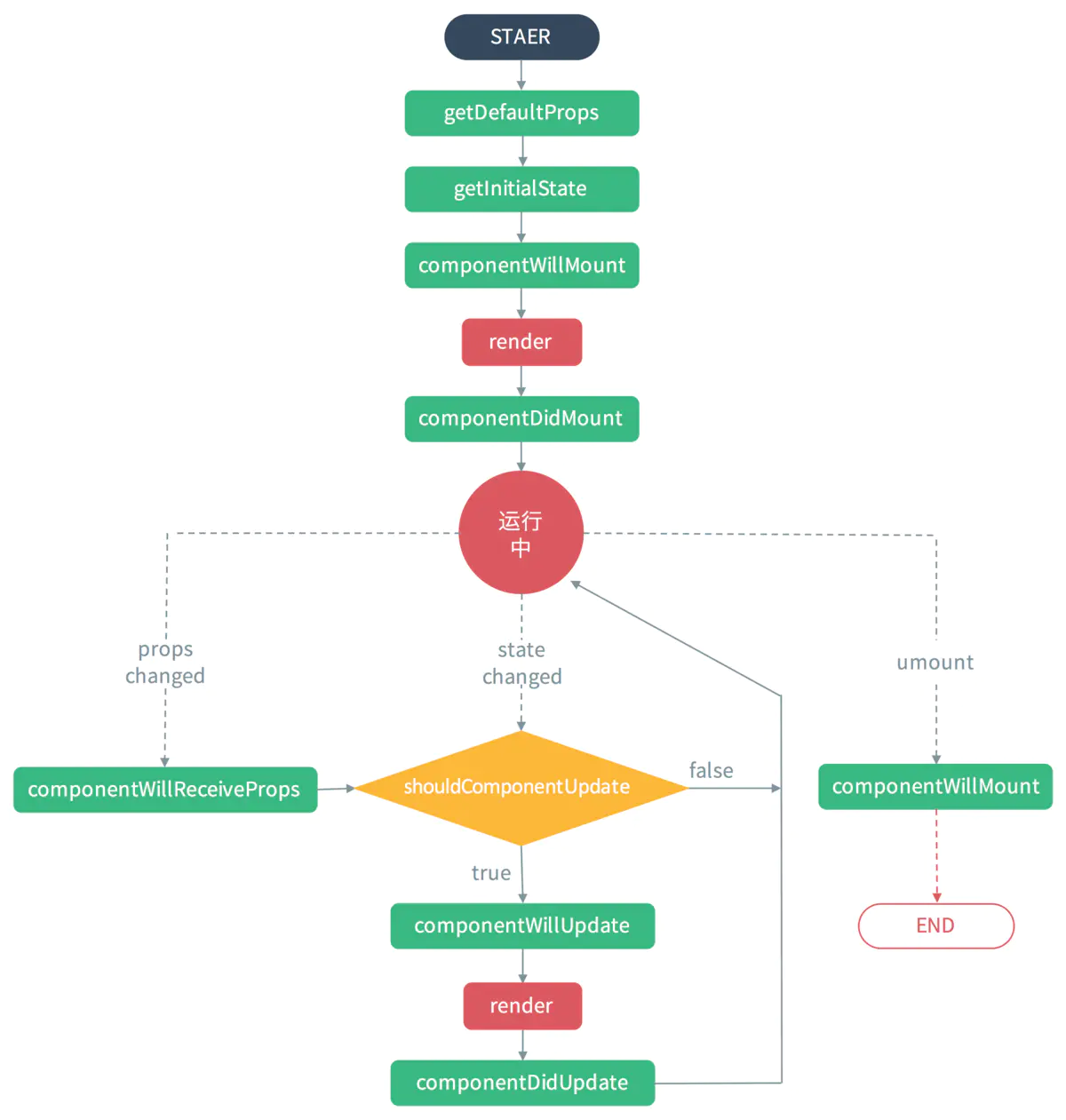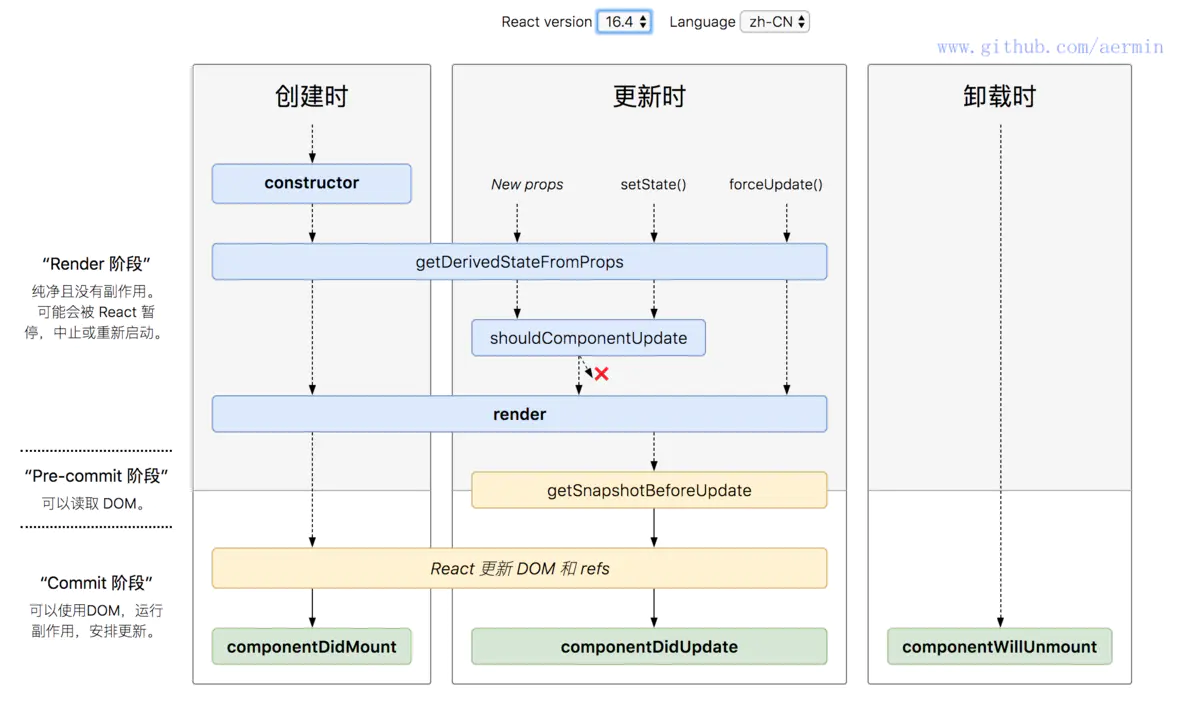# React v16.0 前的生命周期
其实大部分团队不见得会跟进升到 16 版本,所以 16 前的生命周期还是很有必要掌握的,何况 16 也是基于之前的修改

# 第一个是组件初始化(initialization)阶段
也就是以下代码中类的构造方法( constructor() ),Test 类继承了 react Component 这个基类,也就继承这个 · 的基类,才能有 render(),生命周期等方法可以使用,这也说明为什么函数组件不能使用这些方法的原因。
super(props)用来调用基类的构造方法( constructor() ), 也将父组件的 props 注入给子组件,功子组件读取(组件中 props 只读不可变,· 可变)。
而constructor()用来做一些组件的初始化工作,如定义 this.state 的初始内容。
import React, { Component } from 'react';
class Test extends Component {
constructor(props) {
super(props);
}
}
# 第二个是组件的挂载(Mounting)阶段
# 此阶段分为 componentWillMount,render,componentDidMount 三个时期。
componentWillMount: 在组件挂载到 DOM 前调用,且只会被调用一次,在这边调用this.setState不会引起组件重新渲染,也可以把写在这边的内容提前到 constructor()中,所以项目中很少用。render: 根据组件的props和state(无两者的重传递和重赋值,论值是否有变化,都可以引起组件重新render) ,return 一个 React 元素(描述组件,即 UI),不负责组件实际渲染工作,之后由 React 自身根据此元素去渲染出页面 DOM。render 是纯函数(Pure function:函数的返回结果只依赖于它的参数;函数执行过程里面没有副作用),不能在里面执行 this.setState,会有改变组件状态的副作用。componentDidMount: 组件挂载到 DOM 后调用,且只会被调用一次
# 第三个是组件的更新(update)阶段
在讲述此阶段前需要先明确下 react 组件更新机制。setState 引起的 state 更新或父组件重新 render 引起的 props 更新,更新后的 state 和 props 相对之前无论是否有变化,都将引起子组件的重新 render。详细可看这篇文章
# 造成组件更新有两类(三种)情况:
1.父组件重新 render 引起子组件重新 render 的情况有两种,内容及代码修引自xiaoyann 的回答
- a. 直接使用,每当父组件重新
render导致的重传 props,子组件将直接跟着重新渲染,无论 props 是否有变化。可通过 shouldComponentUpdate 方法优化
class Child extends Component {
shouldComponentUpdate(nextProps) {
// 应该使用这个方法,否则无论props是否有变化都将会导致组件跟着重新渲染
if (nextProps.someThings === this.props.someThings) {
return false;
}
}
render() {
return <div>{this.props.someThings}</div>;
}
}
- b.在
componentWillReceiveProps方法中,将props转换成自己的state
class Child extends Component {
constructor(props) {
super(props);
this.state = {
someThings: props.someThings
};
}
componentWillReceiveProps(nextProps) {
// 父组件重传props时就会调用这个方法
this.setState({ someThings: nextProps.someThings });
}
render() {
return <div>{this.state.someThings}</div>;
}
}
根据官网的描述
在该函数(componentWillReceiveProps)中调用 this.setState() 将不会引起第二次渲染。
是因为 componentWillReceiveProps 中判断 props 是否变化了,若变化了,this.setState 将引起 state 变化,从而引起 render,此时就没必要再做第二次因重传 props 引起的 render 了,不然重复做一样的渲染了
- 2.组件本身调用
setState,无论state有没有变化。可通过shouldComponentUpdate方法优化。
class Child extends Component {
constructor(props) {
super(props);
this.state = {
someThings: 1
};
}
shouldComponentUpdate(nextStates) {
// 应该使用这个方法,否则无论state是否有变化都将会导致组件重新渲染
if (nextStates.someThings === this.state.someThings) {
return false;
}
}
handleClick = () => {
// 虽然调用了setState ,但state并无变化
const preSomeThings = this.state.someThings;
this.setState({
someThings: preSomeThings
});
};
render() {
return <div onClick={this.handleClick}>{this.state.someThings}</div>;
}
}
# 此阶段分为 componentWillReceiveProps,shouldComponentUpdate,componentWillUpdate,render,componentDidUpdate
componentWillReceiveProps(nextProps)此方法只调用于 props 引起的组件更新过程中,参数 nextProps 是父组件传给当前组件的新props。但父组件render方法的调用不能保证重传给当前组件的 props 是有变化的,所以在此方法中根据nextProps和this.props来查明重传的props是否改变,以及如果改变了要执行啥,比如根据新的props调用this.setState出发当前组件的重新rendershouldComponentUpdate(nextProps, nextState)此方法通过比较 nextProps,nextState及当前组件的this.props,this.state,返回true时当前组件将继续执行更新过程,返回false则当前组件更新停止,以此可用来减少组件的不必要渲染,优化组件性能。
ps:这边也可以看出,就算 componentWillReceiveProps()中执行了 this.setState,更新了 state,但在 render 前(如 shouldComponentUpdate,componentWillUpdate),this.state 依然指向更新前的 state,不然 nextState 及当前组件的 this.state 的对比就一直是 false 了。
componentWillUpdate(nextProps, nextState)此方法在调用render方法前执行,在这边可执行一些组件更新发生前的工作,一般较少用。renderrender方法在上文讲过,这边只是重新调用。componentDidUpdate(prevProps, prevState)此方法在组件更新后被调用,可以操作组件更新的DOM,prevProps和prevState这两个参数指的是组件更新前的props和state
# 卸载阶段
此阶段只有一个生命周期方法:componentWillUnmount
componentWillUnmount此方法在组件被卸载前调用,可以在这里执行一些清理工作,比如清楚组件中使用的定时器,清楚componentDidMount中手动创建的DOM元素等,以避免引起内存泄漏。
# React v16.4 的生命周期

# 最后
文中若有不准确或错误的地方,欢迎指出,有兴趣可以的关注下Github~
